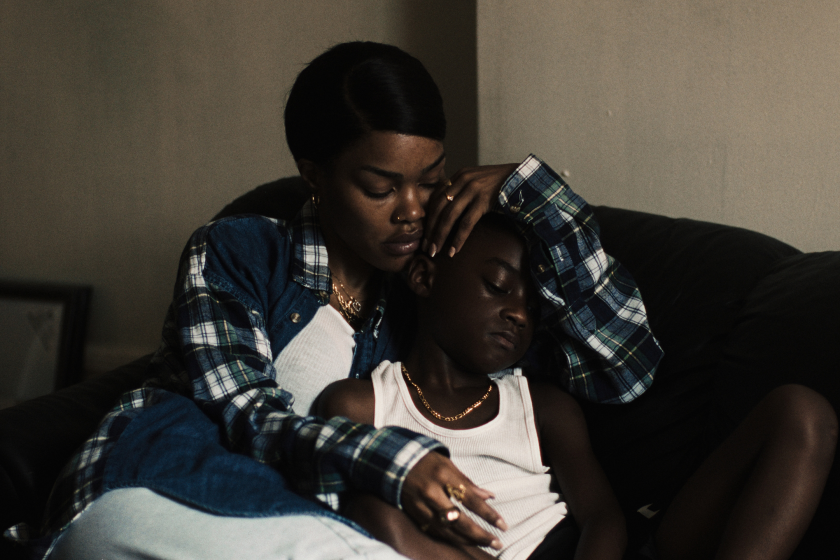Teyana Taylor says postpartum depression and loss fueled her in ‘A Thousand and One’

Teyana Taylor is already getting heaps of acclaim for her gut-wrenching performance in “A Thousand and One.”
She plays Inez, a mother protecting her son amid the hardship of systemic poverty and a gentrifying Harlem.
Behind the acting, the hurt was real for Taylor.
Filmmaker A.V. Rockwell and star Teyana Taylor open up about their ‘heartbreak letter’ and Sundance prizewinner ‘A Thousand and One,’ opening Friday.
“I was actually six months postpartum when we started working on ‘A Thousand and One,’ so I was dealing with literal postpartum depression,” Taylor said in an interview with Yahoo Entertainment.
Months before filming, the singer-actor-dancer had given birth to her second child with husband Iman Shumpert. Rue Rose Shumpert is now 2. While the couple raised their kids, including 7-year-old Iman Tayla Shumpert Jr., Taylor felt very little space to process the pain of postpartum depression.
“That made Inez very therapeutic for me because I was able to cry out loud for once,” Taylor told Yahoo. “I think I hadn’t been able to do that because when you’re a super mom, that’s all your kids see you as, you’re a superhero all day, every day. So going to the set every day, I was able to put my cape to the side, have my therapy session and just cry out loud.”
Teyana Taylor delivers an astonishing performance in filmmaker A.V. Rockwell’s feature debut, a fascinating portrait of fierce maternal instincts on the streets of Harlem.
And on top of postpartum depression, Taylor said she was mourning the recent deaths of childhood friends, as well as dramatic changes in her childhood home of Harlem, where the film is set.
“[I was] back home to film and then come to find out that a lot of [my] childhood has been erased,” she told Yahoo, echoing other recent interviews, including with The Times, in which she talked openly about gentrification in New York City and the ways the film “A Thousand and One” lays such transformations bare.
“They romanticize the ‘new’ New York, but if we’re getting kicked out of it, there ain’t nothing cute about it,” Taylor recently told The Times. “Y’all are dressing it up to get us out to put the other people in. There’s nothing beautiful about what’s going on. It’s almost like your childhood is being taken away from you, like history is being erased out of the textbooks.”
The Sundance Film Festival announced their 2023 awards on Friday, with ‘A Thousand and One’ and ‘Going to Mars’ winning top U.S. jury prizes.
The film’s director, A.C. Rockwell, told The Times in January that talking about gentrification was one of her goals in making the movie, which won the U.S. dramatic grand jury prize at the 2023 Sundance Film Festival.
“I really wanted to talk about how New York City changed [when it began to] prioritize commerce over its communities and its residents,” Rockwell said. “Seeing first-hand the impact of gentrification on the Black communities of New York, it felt like we were getting erased and pushed out of the city altogether.”
Taylor has been in the public eye for a decade leading up to the critical acclaim for “A Thousand and One.” She started as a choreographer and dancer before making music as a singer who was signed first to Pharell Williams’ Star Trak Entertainment, then to Kanye West’s GOOD Music.
Representation by people of color as movie leads and film writers has slid back to 2019 levels, according to UCLA’s Hollywood Diversity Report.
More recently, she found solo commercial success with her 2020 album “The Album,” featuring the hit single “A Rose in Harlem.” As an actor she’s found supporting roles in films since 2010 and in recent years has had larger parts in “Coming 2 America” and the upcoming “White Men Can’t Jump” remake. “A Thousand and One” is her first leading role.
Another layer to her performance as Inez is colorism in the Black community, Taylor shared with The Times. She recalled experiences with colorism as a Black woman growing up in New York City and within the entertainment industry. She said that “a lot of the emotions I put onto Inez were real emotions from real triggers.”
“Any type of quiet battles I was fighting or struggles, I was able to pour it all into Inez and really give my all,” Taylor told Yahoo. “And I think that’s what made it so real and authentic, because every single emotion was real. Every single tear was real. Every single scream was real. Every single emotion was real.”
Times staff writer Sonaiya Kelley contributed to this report.
More to Read
Only good movies
Get the Indie Focus newsletter, Mark Olsen's weekly guide to the world of cinema.
You may occasionally receive promotional content from the Los Angeles Times.















